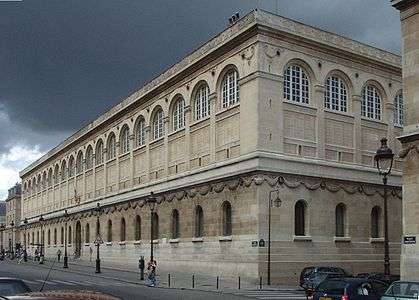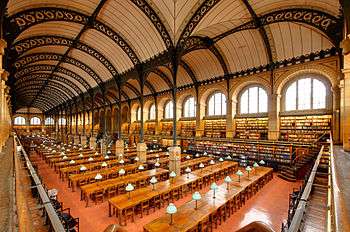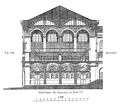Sainte-Geneviève Library


Sainte-Geneviève Library (French: Bibliothèque Sainte-Geneviève) is a public and university library in Paris, which inherited the collection of the Abbey of St Genevieve. The library contains around 2 million documents.[1]
Holdings
The required reading of scripture set forth in the Rule of St Benedict sanctioned the formation of monastic libraries, which typically consisted of volumes either donated to the monastery or copied in its scriptorium. Ste Geneviève, one of the largest and oldest abbeys in Paris, had amassed a large library by the 12thc, the holdings of which are listed in a thirteenth century inventory (Paris, Bibliothèque nationale de France, MS lat. 16203, fol. 71v). The 226 titles and authors included in the inventory show that the monastic library at Ste Geneviève consisted of the core texts essential to monastic life, including bibles, exegetical commentaries and glosses, patristics, ecclesiastical history, customaries and service books. Only a small number of those 226 volumes collected in the twelfth-century library are in the collection of the Bibliothèque Ste Geneviève today.
During a period of decline in the seventeenth century, the library was dispersed in the 17th century and its contents sold, sometimes for the value of their paper alone. In the next century, efforts were made to reconstitute the library by buying back what books remained on the market Later reform resulted in the foundation of the Royal Library Sainte-Genevieve, inherited by present institution.[2]
Architecture
Between 1838 and 1850, a building for the Sainte-Geneviève Library was designed and constructed under the direction of the architect Henri Labrouste. He was given the project in 1838, but construction did not commence until 1843. The glass and iron reading room has been described as "magisterial" and the building itself as a seminal work in the creation of the modern library as "a temple of knowledge and space for contemplation".[3] The names of 810 illustrious scholars are inscribed on the building's facade.[4]
In one scholar's estimation:[5]
One of the greatest cultural buildings of the nineteenth century to use iron in a prominent, visible way was unquestionably the Bibliothèque Ste.-Genevieve in Paris, designed by Henri Labrouste. He presented the design on December 19, 1839. It took six to seven years to complete the construction, from 1843–50. The large (278 by 69 feet) two-storied structure filling a wide, shallow site is deceptively simple in scheme: the lower floor is occupied by stacks to the left, rare-book storage and office space to the right, with a central vestibule and stairway leading to the reading room which fills the entire upper story. The ferrous structure of this reading room—a spine of slender, cast-iron Ionic columns dividing the space into twin aisles and supporting openwork iron arches that carry barrel vaults of plaster reinforced by iron mesh—has always been revered by Modernists for its introduction of high technology into a monumental building.
The exterior of this Parisian library is plain in comparison to the interior's expression of detail in the ironwork and masonry, which is due to Labrouste's appeal to his prior studies of Roman architecture.
Labrouste's limestone structure stands at the Sainte-Genevieve hill, across the street from the Panthéon in the Latin Quarter. When developing his design, Labrouste may have added the leafy garland band above the windows on the first level exterior nearly identical to the band on the Pantheon as a gesture of respect to its neighboring monument.
Charles Follen McKim used the Sainte-Geneviève Library building as the model his design of the main building of the Boston Public Library.[6]
Directors and principal keepers
- Jean Baptiste LeChevalier (1806-1836)
- Charles Kohler ( ? - 1917)
- Charles Mortet (1917–1922)
- Paul Roux-Fouillet (1977–1987)
- Geneviève Boisard (1987–1997)
- Nathalie Jullian (1997–2006)
- Yves Peyré (2006–2015)
- François Michaud (2015 – )
Notable readers
In popular culture
The library's interior was used as the Film Academy Library for scenes of Martin Scorsese's Academy Award-winning 3D film Hugo, based on Brian Selznick's Caldecott Medal-winning novel The Invention of Hugo Cabret, where the title character and Isabelle go to find more information about a film which Hugo did not remember its name (A Trip to the Moon), later both finding out to their surprise that its creator is Georges Méliès, Isabelle's godfather.
Architectural drawings
 Ground floor plan (hall)
Ground floor plan (hall) Main floor plan (reading room)
Main floor plan (reading room) Hall and reading room elevation)
Hall and reading room elevation) Façade
Façade
References
- ↑ Sainte-Geneviève Library, retrieved 1 April 2013
- ↑ Sainte-Geneviève Library: History, retrieved 1 April 2013
- ↑ "Henri Labrouste: Structure Brought to Light". moma.org. March 10, 2013. Retrieved March 23, 2013.
- ↑ Henri Labrouste et la bibliothèque Sainte-Geneviève, Annie Le Saux, BBF 2002 - Paris, t. 47, n° 2
- ↑ Marvin Trachtenberg and Isabelle Hyman, Architecture: from Prehistory to Post-Modernism, p 478
- ↑ Meyer, Adolf Bernhard (1905). Studies of the museums and kindred institutions of New York City, Albany, Buffalo, and Chicago, with notes on some European Institutions. Washington, DC: Smithsonian Institution. pp. 594ff. Retrieved 5 July 2014.
Further reading
- "New Library". Gleason's Pictorial. Boston, Mass. 2. 1852.
External links
| Wikimedia Commons has media related to Bibliothèque Sainte-Geneviève. |
- Official website (in French)
- https://archive.org/details/bibliothequesaintegenevieve
- Henri Labrouste - Bibliothèque Sainte-Geneviève (In French, Standard YouTube License)
Coordinates: 48°50′49.5″N 2°20′45″E / 48.847083°N 2.34583°E